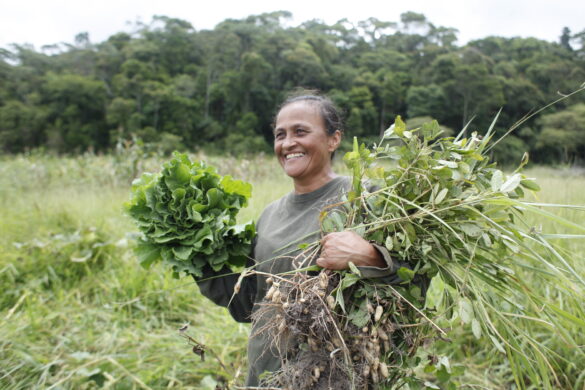Rio de Janeiro, Brazil
The Conexão Mata Atlântica project is an initiative of payments for environmental services (PES) that recognizes priority actions for conservation and restoration in the Atlantic Forest.
The objective is to contribute to climate change mitigation, biodiversity conservation, and water and food security, with the aim of increasing carbon stocks.
Background
The Paraíba do Sul River Basin, which spans the states of Rio de Janeiro, São Paulo and Minas Gerais in Brazil, is located amidst some of the country’s largest industrial and population centers. The water resources of the basin are used to supply water to over 14 million people, generate electricity, dilute effluents and serve other purposes. The basin has experienced extensive deforestation in past centuries. Currently, a significant portion of its territory is covered by degraded and unproductive pastures.
The seasonal forests, which originally covered most of the basin’s area, currently occupy only 3.5% of the territory. The basin faces problems such as degraded soil, rivers with compromised water quality and water scarcity. This scenario combines a high demand for ecosystem services with a framework of environmental degradation (RODRIGUES et al., 2018; ANA, 2019). The basin is also inserted in the Atlantic Forest biome, which combines exceptional diversity with a loss of habitat in large proportions. Natural, complex and diverse ecosystems have been extensively and intensely replaced by simplified and poorly diverse agroecosystems – which make up approximately 70% of the basin area (AGEVAP, 2021).
In this context, policies that reward and incentivize those who provide environmental services, improving the profitability of activities for protection and sustainable use of natural resources, are essential. An important mechanism is Payment for Environmental Services (PES), an economic instrument that establishes the provider-receiver principle and that has been increasingly adopted in the country and in the State of Rio de Janeiro to enable conservation actions and environmental recovery in hydrographic basins.
Payments for environmental services (PES)
The PES mechanism, directed towards agroecosystems and areas with high anthropogenic impact, adopted by the Conexão Mata Atlântica project, has created conditions for the recognition and financial incentive for rural producers in the state who contribute – through these environmental actions and the consequent increase in soil carbon stocks – to the conservation of biodiversity and the mitigation of climate change.
The project considers three types of practices eligible for PES receipt:
- Forest Conservation: Aims to reduce fragmentation by stimulating the connectivity of biological corridors through the protection and regeneration of forest fragments. The provision of environmental services is carried out through actions of isolation and fencing, implementation of firebreaks and enrichment of forest remnants.
- Ecological Restoration: It is directed at the stimulation, recovery and increase of connectivity between forest fragments and the reduction of the edge effect, which increases forest areas and stimulates the recovery of areas of high importance for water resources and biodiversity conservation. The provision of environmental services is carried out through actions of isolation and fencing, implementation of firebreaks, soil recovery, control of invasive or exotic species and forest restoration.
- Productive Conservation: Aims to promote the conversion of low productivity areas into systems of greater ecological and economic functionality, through the development of agroforestry, silvopastoral systems or forest consortia with tree components of native species or native species intercropped with exotic species.
Environmental, socioeconomic and policy impacts
The actions of training, technical assistance and dissemination of forest consortiums, silvopastoral and agroforestry systems, associated with the PES aimed at the productive conversion of areas of low productivity into productive systems of greater ecological and economic functionality (agroforestry, silvopastoral systems and forest consortiums), proved to be very successful, with great adhesion on the part of rural owners. This strategy has proven to be effective, especially for the recovery of degraded pastures.
The financial support through PES proved to be a crucial incentive for achieving scalability since it enables the landowner to directly implement the supported environmental practices at a reduced cost compared to third-party execution, particularly for small rural properties. As a lesson learned, there is an intention to expand this type of incentive in new PES projects.
- Environmental impacts: Two public selections for PES were conducted, resulting in a total of 237 contracts. The implemented and monitored environmental actions cover nearly 2,440 hectares, including 1,562 hectares of conserved forests, 321 hectares of forest restoration, and 542 hectares of conversion from low-productivity areas to more sustainable systems, such as agroforestry and silvopastoral systems, which integrate native trees with crops and pasture.
- Socioeconomic impacts: PES investments in the project totaled US$1.7 million. These resources have contributed to changing the reality of farming families who lack their own funds or access to credit lines to implement environmental practices or improvements in production systems. Additionally, it has helped stimulate the local economy. Through productive conversion, the conversion of the 542 hectares of degraded pastures of low productivity into agroforestry and silvopastoral systems promoted environmental gains and increased the income of producers. In this way, economic, social and environmental benefits are simultaneously generated.
Associations and partnerships
To achieve its objectives and goals, the project has relied on the support of various partners from different levels of government, the private sector and civil society organizations since its inception.
- From the institutional point of view, the project is the result of a partnership between the state secretariats of the Environment and of Agriculture. This union was fundamental to the success in the adhesion of the producers and progress of the project.
- There are also partnerships with public greenhouses and socio-environmental projects for the production of seedlings to donate species for restoration and productive conversion actions. Additionally, partnerships with educational institutions, universities, associations, cooperatives, and local municipalities have been established.
- The Brazilian Agricultural Research Corporation (EMBRAPA) has contributed to research activities related to ecosystem services, PES and conservation management of soil and water in the area covered by the project related to ecosystem services.
- The Grupo Boticário Foundation (FGB) provided technical support for strengthening the state’s PES policy, accelerating impact businesses and developing the project’s financial sustainability strategy.
- The Nature Conservancy (TNC) is a partner in the development of a platform for PES contract management, area monitoring and data geoprocessing, facilitating and optimizing management and the technical workforce.
All of the photos belong to the State of Rio de Janeiro and Gustavo Stephan





Access the project’s official website here, and learn about the project’s enablers, key activities and innovations, impacts in several areas, partnerships and replicability in the Case Study Database here.





